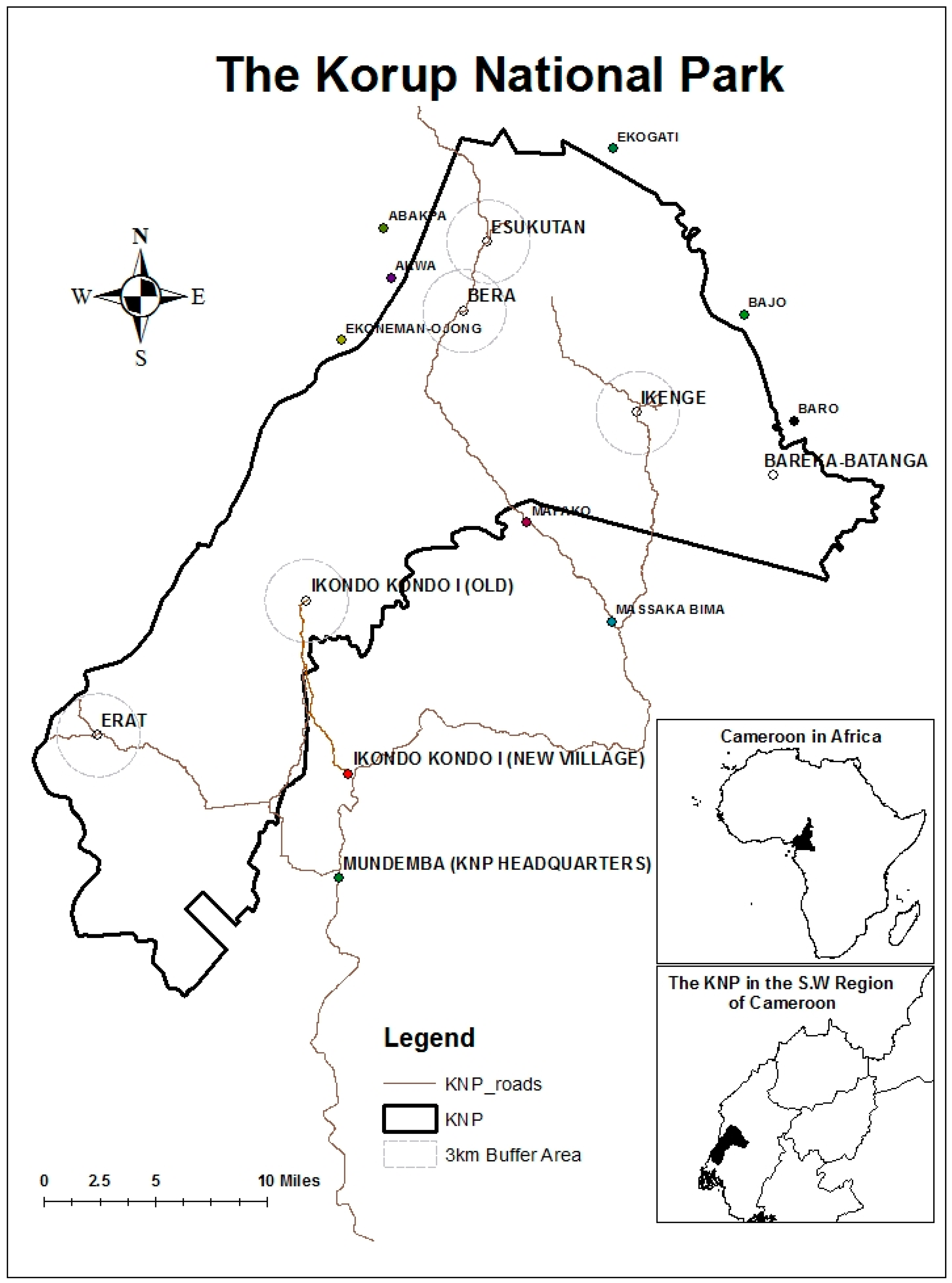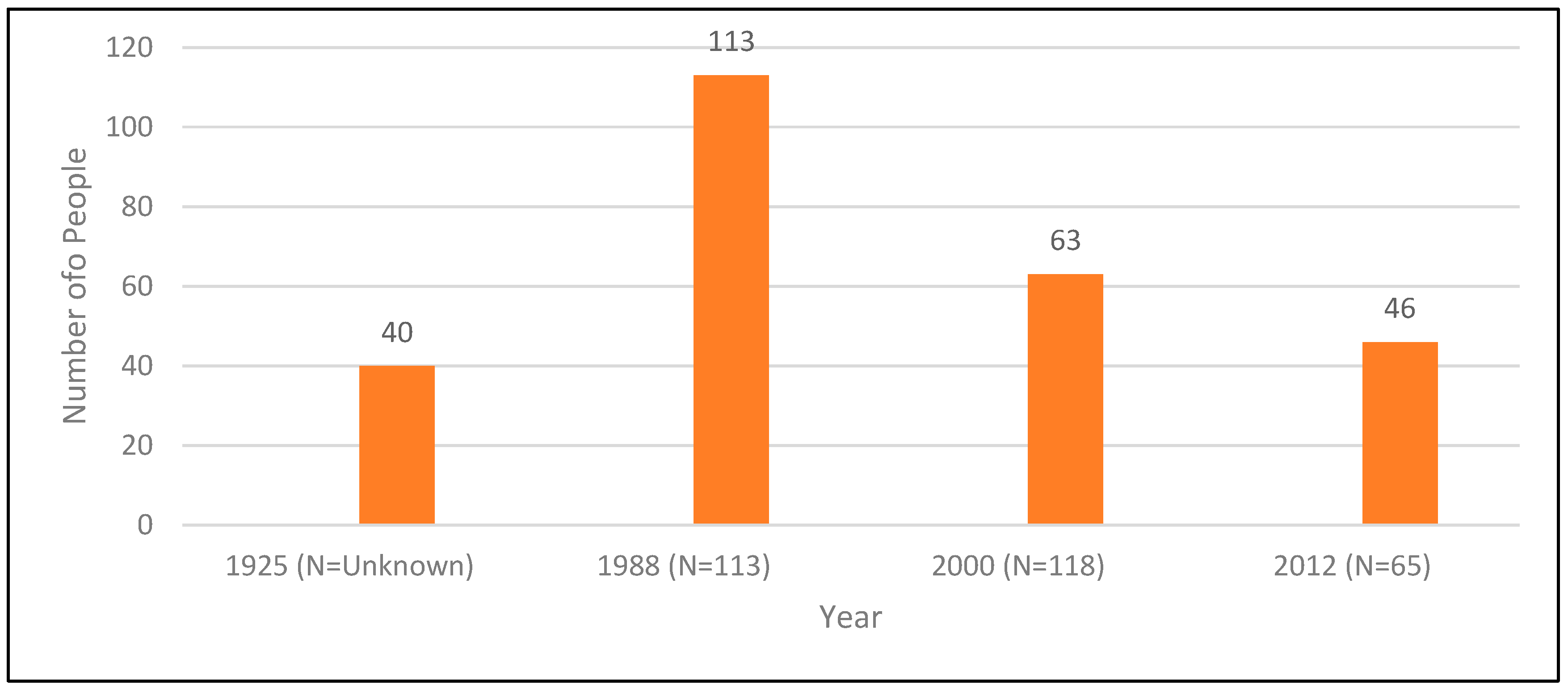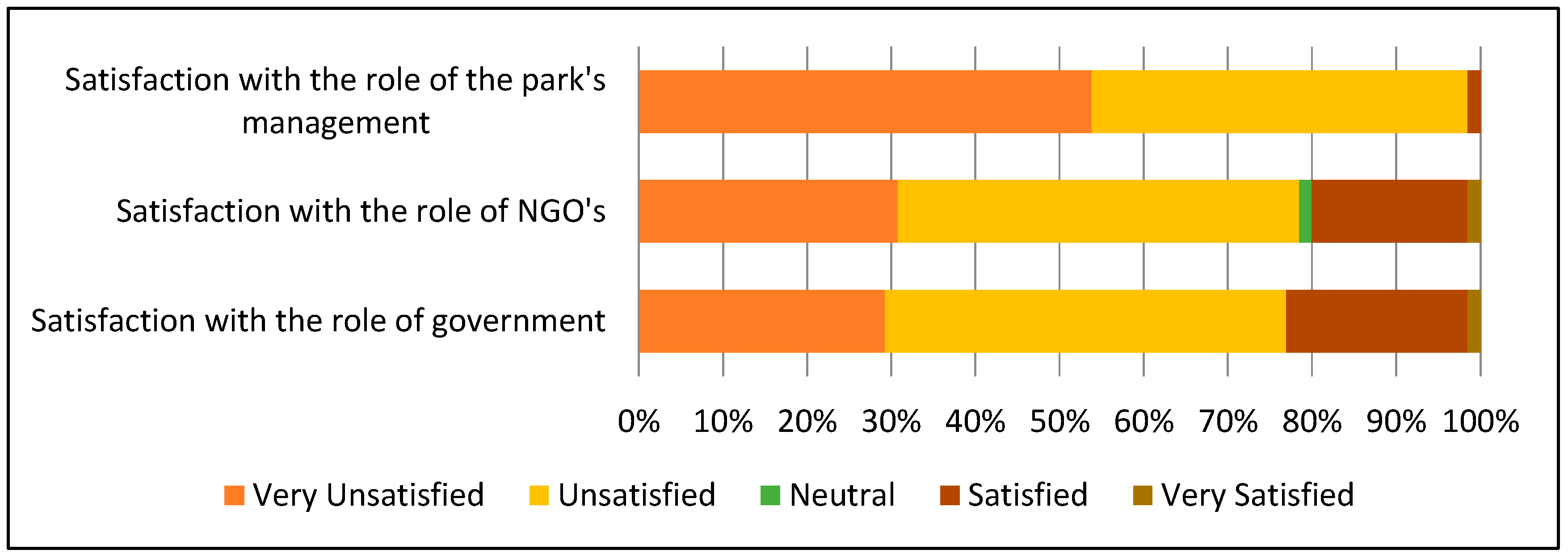The Politics of Land Use in the Korup National Park
Abstract
:1. Introduction
1.1. Land Change Science and Environmental Change
Political Ecology of Environmental Change
political dimensions of the interaction between the state, and other actors, and the places where they live. It sees politics as the competition between humans over the division of resources, and looks at the means by which different actors deploy whatever power they have to achieve their ends.([28]; p. 359)
1.2. Evolution of Parks in Cameroon
Creation of the Korup National Park: Background and History
2. Methods
2.1. Ethnographic Methods
2.2. Quantitative Methods
3. Consequences of Conservation Policies in the KNP
3.1. Land-Use and Land-Cover Change at the Community Scale
3.2. Population
3.3. Hunting
I used to hunt when I was young and had the strength to walk long distances for bush meat. Today, I am no longer as strong as I used to be and the animals have reduced in number. Hunters now have to trek longer distances and sleep many more days in the forest to get half of what we used to get, in half the time. I no longer have that kind of strength left, and I would rather use the little I have on my cocoa farm2.
“No I don’t. Who will take care of my wife and children if I go to prison?”
3.4. Cocoa Farming
“Cocoa is now our way of life. That is where the money is and I have to open up more cocoa farms so that I can leave an inheritance for my children. Here in the park I do not have money to give to them or a house to leave for them. What I have are these farms and I must cultivate them because this land is ours, given to us by our forefathers.”
“Only a foolish person will not develop a cocoa farm today. Almost everybody has a small cocoa farm, even those that are in school in Mamfe (neighboring town to the KNP). We are not leaving this land anymore, so why not plant something that will benefit you and your family in the future.”
“Hunting provides quick money, which is good when you have an emergency, but it is also very dangerous. Cocoa farming takes time but once you have it planted and matured, you are set and assured of money year in and year out.”
“Cocoa is good because it cannot be seized or taken from us. Game guards can seize guns and bush meat, but they cannot seize our cocoa. I will plant as much as I can.”
“Cocoa is now the most profitable farming activity for us here in the park. I would plant more cocoa if I had the means of transporting the produce to the market. We have to pay young people today to transport our cocoa (head transport) to the next village from where it is picked up by the buyer. The costs are high, and there have been cases where cocoa rots in the village because there was no one to transport it to the next village.”
3.5. Indigenous Satisfaction with the KNP Management
4. Discussions and Conclusions
Acknowledgments
Author Contributions
Conflicts of Interest
References
- Nepstad, D.C.; Claudia, C.M.; Britaldo, S.B.; Merry, F. Interactions among Amazon land use, forest and climate: prospects for a near-term forest tipping point. Philos. Trans. R. Soc. B 2008, 363, 1737–1746. [Google Scholar] [CrossRef] [PubMed]
- Defries, R.; Achard, F. New estimates of tropical deforestation and terrestrial carbon fluxes: Result of two complementary studies. LUCC Newsl. 2002, 8, 7–9. [Google Scholar]
- Terborgh, J.; Van Schaik, C. Why the world needs parks. In Making Parks Work: Strategies for Preserving Tropical Nature; Van Schaik, C., Terborgh, L.J., Rao, M., Eds.; Island Press: Washington, DC, USA, 2002; pp. 3–14. [Google Scholar]
- Barnsley, I. Reducing Emissions from Deforestation and Forest Degradation in Developing Countries (REDD): A Guide for Indigenous Peoples; IAS Guide; United Nations University: Tokyo, Japan, 2008. [Google Scholar]
- Pagiola, S. Payments for environmental services in Costa Rica. Ecol. Econ. 2008, 65, 712–724. [Google Scholar] [CrossRef] [Green Version]
- Adaman, F.; Hakyemez, S.; Ozkaynak, B. The political ecology of Ramsar Site conservation failure: The case of Burdur Lake, Turkey. Environ. Plan. C Gov. Policy 2009, 27, 783–800. [Google Scholar] [CrossRef]
- Naughton-Treves, L.; Holland, M.B.; Brandon, K. The role of protected areas in conserving biodiversity and sustaining local livelihoods. Annu. Rev. Environ. Resour. 2005, 30, 219–252. [Google Scholar] [CrossRef]
- Fabricius, C.; de Wet, C. The influence of forced removals and land restitutions on conservation in South Africa. In Displacement, Forced Settlement and Sustainable Development; Chatty, D., Colchester, M., Eds.; Bergmann: Oxford, UK, 2002; pp. 149–163. [Google Scholar]
- Brannstrom, C.; Vadjunec, M. Notes for avoiding a missed opportunity in sustainability science: Integrating land change science and political ecology. In Land Change Science, Political Ecology, and Sustainability; Synergies and Divergences; Brannstrom, C., Vadjunec, M., Eds.; Routledge: New York, NY, USA, 2013; pp. 1–23. [Google Scholar]
- Moran, E.F.; Skole, D.L.; Turner, B.L., II. The development of the International Land-Use and Land-Cover Change (LUCC) Research Program and its links to NASA’s Land-Cover and Land-Use Change (LCLUC) Initiative. In Land Change Science: Observing, Monitoring and Understanding Trajectories of Change on the Earth’s Surface; Gutman, G., Janetos, A.C., Justice, C.O., Moran, E.F., Mustard, J.F., Rindfuss, R.R., Skole, D., Turner, B.L., II, Cochrane, M.A., Eds.; Kluwer Academic Publishers: Dordrecht, The Netherlands, 2004. [Google Scholar]
- Blaikie, P.; Brookfield, H. Land Degradation and Society; Methuen & Co Inc.: London, UK, 1987. [Google Scholar]
- Turner, B.L., II; Robbins, P. Land-Change Science and Political Ecology: Similarities, Differences, and Implications for Sustainability. Annu. Rev. Environ. Resour. 2008, 33, 295–316. [Google Scholar] [CrossRef]
- Walker, R.; Richards, P. The ghost of Von Thünen lives. A political ecology of the disappearance of the Amazonian forest. In Land Change Science, Political Ecology, and Sustainability; Synergies and Divergences; Brannstrom, C., Vadjunec, M., Eds.; Routledge: New York, NY, USA, 2013; pp. 24–47. [Google Scholar]
- Zimmerer, K.S. Cultural ecology (and political ecology) in the ‘environmental borderlands’: Exploring the expanded connectivities within geography. Progr. Hum. Geogr. 2007, 31, 227–244. [Google Scholar] [CrossRef]
- Rindfuss, R.R.; Walsh, S.J.; Turner, B.L., II; Fox, J.; Misha, V. Developing a science of land change: Challenges and methodological issue. Proc. Natl. Acad. Sci. USA 2004, 101, 13976–13981. [Google Scholar] [CrossRef] [PubMed]
- Turner, B.L., II; Kasperson, R.E.; Matson, P.A.; McCarthy, J.J.; Corell, R.W.; Christensen, L.; Eckley, N.; Kasperson, J.X.; Luers, A.; Martello, M.L. A framework for vulnerability analysis in sustainability science. Proc. Natl. Acad. Sci. USA 2003, 100, 8074. [Google Scholar] [CrossRef] [PubMed]
- Geoghegan, J.; Pritchard, L., Jr.; Ogneva-Himmelberger, Y.; Chowdhury, R.R.; Sanderson, S.; Turner, B.L., II. “Socializing the Pixel” and “Pixelizing the Social” in land-use and land-cover change. In People and Pixels; Linking Remote Sensing and Social Science; Liverman, D., Moran, E.F., Rindfuss, R.R., Stern, P.C., Eds.; National Academy Press: Washington, DC, USA, 1998; pp. 51–69. [Google Scholar]
- Robbins, P. Political Ecology: A Critical Introduction; Blackwell: Oxford, UK, 2004. [Google Scholar]
- Brockington, D. Fortress Conservation. The Preservation of the Mkomazi Game Reserve, Tanzania; James Currey: Oxford, UK, 2002. [Google Scholar]
- Brockington, D. Community conservation, inequality and injustice: Myths of power in protected area management. Conserv. Soc. 2004, 2, 411–432. [Google Scholar]
- Blaikie, P. The Political Economy of Soil Erosion in Developing Countries; Longman: London, UK, 1985. [Google Scholar]
- Fairhead, J.; Leach, M.; Scoones, I. Green grabing: A new appropriation of Nature? J. Peasant Stud. 2012, 39, 237–261. [Google Scholar] [CrossRef] [Green Version]
- Escobar, A. Construction nature: Elements for a post-structuralist political ecology. Futures 1996, 28, 325–343. [Google Scholar] [CrossRef]
- Fletcher, R. Neoliberal environmentality: Towards a poststructuralist political ecology of the conservation debate. Conserv. Soc. 2010, 8, 171–181. [Google Scholar] [CrossRef]
- Lestrelin, G.; Castella, J.-C.; Fox, J. Forest transitions in Southeast Asia: Synergies and shortcomings in land change science and political ecology. In Land Change Science, Political Ecology, and Sustainability; Synergies and Divergences; Brannstrom, C., Vadjunec, M., Eds.; Routledge: New York, NY, USA, 2013; pp. 48–65. [Google Scholar]
- Adger, W.N.; Benjaminsen, T.A.; Brown, K.; Svarstad, H. Advancing a political ecology of global environmental discourses. Dev. Change 2001, 32, 681–715. [Google Scholar] [CrossRef]
- Neumann, R.P. Nature-state-territory: Towards a critical theorization of conservation enclosure. In Liberation Ecologies: Environmental, Development, Social Movements; Peet, R., Watts, M., Eds.; Routledge: London, UK, 2004; pp. 195–217. [Google Scholar]
- Page, B. The PE of “Prunus African” in Cameroon. R. Geogr. Soc. 2003, 4, 357–370. [Google Scholar]
- Otutei, E. The Political Ecology of forest management in Ghana: Actors, interests and practices in the Assin North Municipality. J. Environ. Earth Sci. 2014, 4, 108–121. [Google Scholar]
- Zimmerer, K.S.; Basset, T.J. (Eds.) Political Ecology: An Integrative Approach to Geography and Environment-Development Studies; Guilford Press: New York, NY, USA, 2003.
- Kull, C.A. Observation on repressive environmental policies and landscape burning strategies in Madagascar. African Studies Quarterly 1999, 3, 1–7. [Google Scholar]
- Turner, M.D. Political ecology and the moral dimensions of “resource conflicts”: The case of farmer-herder conflicts in the Sahel. Political Geogr. 2004, 23, 863–889. [Google Scholar] [CrossRef]
- Adams, W.M.; Hutton, J. People, parks and poverty: Political Ecology and biodiversity conservation. Conserv. Soc. 2007, 5, 147–183. [Google Scholar]
- Rocheleau, D.E. Political ecology in the key of policy: From chains of explanation to webs of relation. Geoforum 2008, 39, 716–727. [Google Scholar] [CrossRef]
- Khan, M.T. Theoretical frameworks in political ecology and participatory nature/forest conservation: The necessity for a heterodox approach and critical moment. J. Polit. Ecol. 2013, 20, 460–472. [Google Scholar]
- Jarosz, L. Defining and explaining tropical deforestation: Shifting cultivation and population growth in colonial Madagascar (1896–1940). Econ. Geogr. 1993, 69, 366–379. [Google Scholar] [CrossRef] [PubMed]
- McGregor, J. Conservation, control and ecological change: The politics and ecology of colonial conservation in Shurugwi, Zimbabwe. Environ. Hist. 1995, 1, 257–279. [Google Scholar] [CrossRef]
- Tchamie, T.T.K. Learning from local hostility to protected areas in Togo. Unasylva 1994, 45, 22–27. [Google Scholar]
- Malleson, R.C. Forest Livelihoods in Southwest Province, Cameroon: An Evaluation of the Korup Experience. Ph.D. Thesis, Department of Geography, University College London, London, UK, 2000. [Google Scholar]
- Tiani, A.M.; Diaw, M.C. Does resettlement contribute to conservation? The case of the Ikundu-kundu, Korup National Park, Cameroon. Policy Matters 2006, 14, 113–127. [Google Scholar]
- Diaw, C.; Tiani, A.; Jum, C.; Milol, A.; Wandji, D. Assessing Long-Term Management Options for the Villages in the Korup National Park: An Evaluation of All Options; Cooperation Cameroun/Union Europeenne, WWF, CIFOR: Yaounde, Cameroon, 2003. [Google Scholar]
- Büscher, B. The Neoliberalisation of Nature in Africa. In New Topographies of Power? In Africa Negotiating an Emerging Multipolar World; Dietz, T., Havnevik, K., Kaag, M., Ostigard, T., Eds.; Brill: Leiden, The Netherlands, 2011; pp. 84–109. [Google Scholar]
- Malleson, R.C. Changing perspectives on forests, people and “development”: Reflection on the case of the Korup forest. Inst. Dev. Stud. Bull. 2002, 33, 94–101. [Google Scholar] [CrossRef] [Green Version]
- Somorin, O.A.; Visseren-Hamakers, I.J.; Arts, B.; Sonwa, D.J.; Tiani, A.M. REDD+ policy strategy in Cameroon: Actors, institutions and governance. Environ. Sci. Policy 2014, 35, 87–97. [Google Scholar] [CrossRef]
- Ministry of Environment and Wildlife. Management Plan for the Korup National Park and its Peripheral Zone 2009–2013; 2008.
- Parren, M.P.E.; de Graaf, N.R. The Quest for Natural Forest Management in Ghana, Cote D’lvoire and Liberia; Tropenbos Foundation: Wageningen, The Netherlands, 1995. [Google Scholar]
- Adams, J.S.; McShane, T.O. The Myth of Wild Africa: Conservation without Illusion; W.W. Norton and Co.: New York, NY, USA, 1992. [Google Scholar]
- Gartlan, J.S. The Korup Regional Management Plan: Conservation and Development in the Ndian Division of Cameroon; WWF: Gland, Switzerland, 1985. [Google Scholar]
- Gartlan, J.S. La Conservation des Ecosystems Forestiers du Cameroun; IUCN: Gland, Switzerland, 1991. [Google Scholar]
- Terborgh, J.; Peres, C.A. The problem of people in parks. In Making Parks Work: Strategies for Preserving Tropical Nature; Van Schaik, C., Terborgh, L.J., Rao, M., Eds.; Island Press: Washington, DC, USA, 2002; pp. 307–319. [Google Scholar]
- Schmidt-Soltau, K.; Brockington, D. Protected Areas and resettlement: What Scope for Voluntary Relocation. World Dev. 2007, 35, 2182–2202. [Google Scholar] [CrossRef]
- Gartlan, J.S. Every man for himself and God against all: History, social science and the conservation of nature. In Resources Use in the Tri-National Sangha River Region of Equatorial Africa: Histories, Knowledge Forms, and Institutions; Eves, H., Hardin, R., Rupp, S., Eds.; Bulletin 102; Yale School of Forestry and Environmental Studies: New Haven, CT, USA, 1998; pp. 216–226. [Google Scholar]
- Brockington, D.; Duffy, R.; Igoe, J. Nature Unbound: Conservation, Capitalism and the Future of Protected Areas; Earthscan: London, UK, 2008. [Google Scholar]
- Sullivan, S. Green capitalism, and the cultural poverty of construction nature as service provider. Radic. Anthropology 2009, 3, 18–27. [Google Scholar]
- Stubina, R. Cameroonian Safety Nets in the Korup National Forest. Ph.D. Thesis, University of Florida, Gainesville, FL, USA, 2002. [Google Scholar]
- Mbile, P.; Vabi, M.; Meboka, M.; Okon, D.; Arrey-Mbo, J.; Nkongho, F.; Ebong, E. Linking management and livelihood in environmental conservation: Case of the Korup National Park Cameroon. J. Environ. Manag. 2005, 76, 1–13. [Google Scholar] [CrossRef] [PubMed]
- Infield, M. Hunting, Trapping and Fishing in Villages within and on the Periphery of the Korup National Park; WWF: Gland, Switzerland, 1988. [Google Scholar]
- Ruitenbeek, J. Social Cost-Benefit Analysis of the Korup Project, Cameroon; WWF and the Republic of Cameroon: London, UK, 1989. [Google Scholar]
- Cope, M. Coding qualitative data. In Qualitative Research methods in Human Geography, 2nd ed.; Hay, I., Ed.; Oxford University Press: Oxford, UK, 2005; pp. 223–233. [Google Scholar]
- Siewe, S. Deforestation: Impact on Carbon Stocks, Biodiversity and the Effects of Conservation Policies on the People and Forests of the Korup National Park (KNP). Ph.D. Thesis, Oklahoma State University, Stillwater, OK, USA, 2015. [Google Scholar]
- Nagendra, H.; Pareeth, S.; Ghate, R. People within parks—Forest villages, land-cover change and landscape fragmentation in the Tadoba Andhari Tiger Reserve, India. Appl. Geogr. 2006, 26, 96–112. [Google Scholar] [CrossRef]
- Vadjunec, J.; Rocheleau, D. Beyond forest cover: Land use and biodiversity in rubber trail forests of the Chico Mendes Extractive Reserve. Ecol. Soc. 2009, 14, 29. [Google Scholar] [CrossRef]
- Jepson, W.; Brannstrom, C.; Filippi, A. Access regimes and regional land change in Brazilian Cerrado, 1972–2002. Ann. Assoc. Am. Geogr. 2010, 100, 87–111. [Google Scholar] [CrossRef]
- Schmock, B.; Dickson, R.P.; Sangermano, F.; Vadjunec, J.M.; Eastman, J.R.; Rogan, J. A step-wise land-cover classification of the tropical forest of the Southern Yucatan, Mexico. Int. J. Remote Sens. 2011, 32, 1139–1164. [Google Scholar] [CrossRef]
- Jensen, J. Remote Sensing of the Environment; Prentice Hall: Upper Saddle River, NJ, USA, 2009. [Google Scholar]
- Vadjunec, J.; Schneider, L.; Turner, B.L., II. Land change Science: The Contributions of Latin Americanist Geographers to Global Environmental Change and Sustainability Research. Conf. Lat. Am. Geogr. Yearb. 2002, 27, 171–205. [Google Scholar]
- Kusimi, J.M. Assessing Land-use and Land-cover Change in the Wassa West District of Ghana using Remote Sensing. J. Land Use Sci. 2008, 71, 249–259. [Google Scholar] [CrossRef]
- Roschenthaler, U. Culture, History and Perceptions on Resettlement: A Baseline Study of the Six Villages in the Korup National Park; University of Frankfurt: Frankfurt am Main, Germany, 2000. [Google Scholar]
- Hecth, S. Environment, development and politics: Capital accumulation and the livestock sector in eastern Amazonia. World Dev. 1985, 13, 663–684. [Google Scholar]
- Chomitz, K.M.; Gray, D.A. Roads, land use and Deforestation: A spatial Model applied to Belize. World Bank Econ. Rev. 1996, 10, 487–512. [Google Scholar] [CrossRef]
- Kull, A.C. Deforestation, erosion and fire: Degradation myths in the environmental history of Madagascar. Environ. Hist. 2000, 6, 423–450. [Google Scholar] [CrossRef]
- Mamdani, M. The Myth of Population Control: Family Caste and Class in an Indian Village; Monthly Review Press: New York, NY, USA, 1973. [Google Scholar]
- Aweto, A.O. Shifting Cultivation and Secondary Succession in the Tropics; CAB International: Wallingford, UK, 2012. [Google Scholar]
- Gartlan, J. The biological importance of the Korup forest. In Proceedings of the Workshop on Korup National Park, Mundemba; Gartlan, J.S., Macleod, H., Eds.; WWF/IUCN Project 3206; Gland, Switzerland, 1986; pp. 123–145. [Google Scholar]
- Cantle. Report on the Obang and Bakoko. Buea National Archives, #1470/1925 Af 52. 1925. [Google Scholar]
- Parrott, J. Korup National Park Household Survey, KNP Report. 1988.
- Schmidt-Soltau, K. Resettlement and conservation in the Central African rainforest: The case of the Korup National Park. In Proceedings of the 10th World Congress of Rural Sociology, Rio de Janeiro, Brazil, 30 July–5 August 2000.
- Linder, M.J.; Oates, J.F. Differential impact of bush meat hunting on monkey species and implications for primate conservation in Korup National Park, Cameroon. Biol. Conserv. 2011, 144, 738–745. [Google Scholar] [CrossRef]
- Neumann, R.P. Primitive Ideas: Protected area buffer zones and the politics of land in Africa. Dev. Chang. 1997, 28, 559–582. [Google Scholar] [CrossRef]
- Brian, K. Shifting spaces and hidden landscapes in rural South Africa. In Land Change Science, Political Ecology, and Sustainability; Synergies and Divergences; Brannstrom, C., Vadjunec, M., Eds.; Routledge: New York, NY, USA, 2013; pp. 191–223. [Google Scholar]
- Siewe, S.; Vadjunec, M. Biodiversity and carbon stock dynamics in the Cameroon National Park Cameroon. 2015; unpublished. [Google Scholar]
- Radel, C.; Schmook, B.; Mendez, C. Gender, the household and land change in Southern Mexico. In Land Change Science, Political Ecology, and Sustainability; Synergies and Divergences; Brannstrom, C., Vadjunec, M., Eds.; Routledge: New York, NY, USA, 2013; pp. 107–128. [Google Scholar]
- 1For this study, a compound is defined as a multi-family household, where a group of people live together in the same house, but have different families, own separate properties, and are engaged in different land use activities. These different families can be polygamous, or monogamous. In each case, households stay separated from each other.
- 2Interviewees identities are confidential and anonymous. Names of participants are, therefore, withheld.





| ID | Class | Description |
|---|---|---|
| 0 | Background | Unclassified area outside the area of study |
| 1 | Forest 2013 | Dense, closed tropical forest common to the KNP park |
| 2 | Water | Rivers, creek, ponds, and other water bodies |
| 3 | Non-forest 2000 | Areas lacking green vegetation cover and/or bare soil (2000). |
| 4 | Non-forest 2013 | Areas lacking green vegetation cover and/or bare soil (2013). |
| 5 | Forest regrowth 2013 | Areas that changed from being bare of vegetation in 2000 to being forest (regrowth) in 2013. |
| Bera | Esukutan | Ikenge | Erat | KNP | |
|---|---|---|---|---|---|
| Deforested in 2000 | 43.1 (1.51%) | 85.1 (3.15%) | 38.5 (3.01%) | 247.8 (8.68%) | 994.7 (7.12%) |
| Deforested in 2013 | 10.4 (0.37%) | 70.1 (2.46%) | 115 (4.03%) | 168.6 (5.91%) | 760.9 (5.16%) |
| Total Deforestation (2000–2013) | 53.5 (1.88%) | 155.2 (5.61%) | 153.5 (7.04%) | 416.5 (14.59%) | 1755.7 (12.28%) |
| Forest Regrowth (2000–2013) | 39.6 (1.38%) | 57 (2%) | 51.1 (1.79%) | 164.2 (5.75%) | 687.4 (4.6%) |
© 2017 by the authors. Licensee MDPI, Basel, Switzerland. This article is an open access article distributed under the terms and conditions of the Creative Commons Attribution (CC BY) license ( http://creativecommons.org/licenses/by/4.0/).
Share and Cite
Siewe, S.; Vadjunec, J.M.; Caniglia, B. The Politics of Land Use in the Korup National Park. Land 2017, 6, 7. https://doi.org/10.3390/land6010007
Siewe S, Vadjunec JM, Caniglia B. The Politics of Land Use in the Korup National Park. Land. 2017; 6(1):7. https://doi.org/10.3390/land6010007
Chicago/Turabian StyleSiewe, Siewe, Jacqueline M. Vadjunec, and Beth Caniglia. 2017. "The Politics of Land Use in the Korup National Park" Land 6, no. 1: 7. https://doi.org/10.3390/land6010007







